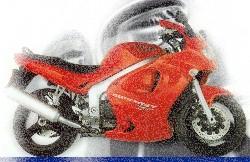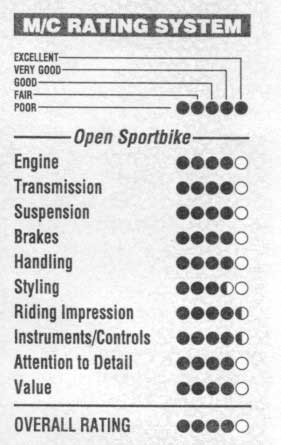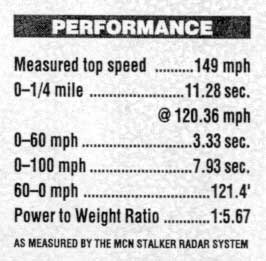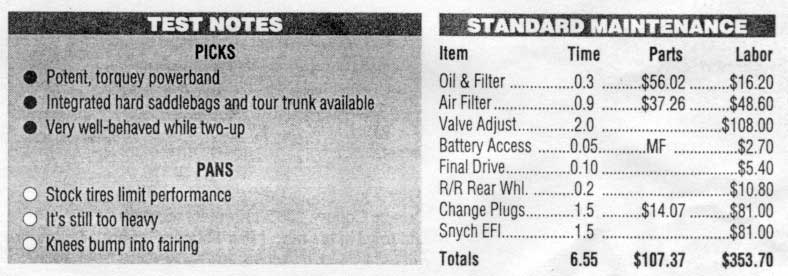
Motorcycle Consumer News
August 1999
Toll Free order number (888-333-0354)
Web site at www.mcnews.com
The following article appeared in the August 1999 issue of Motorcycle Consumer News (Vol 30 No 8). Copyright 1999 - Motorcycle Consumer News
Motorcycle Consumer News is wholly supported by its readers - because of this, their opinions and reviews are "unswayed by industry influences on reporting". More samples of their publication can be viewed on their website - kind of refreshing in this age of the almighty advertising dollar. -Eric
Model Evaluation - Triumph Sprint ST
BACK IN APRIL, 1996, an eight-man design, manufacturing and marketing team inside Triumph was given an assignment right out of "Mission Impossible": Not simply to produce a bike of sufficient talent that nostalgia for Triumph's famous name and its Anglophile "character" could ensure its sales, but to take on and beat Honda's very best, the stellar VFR75O.
Imagine the team sitting around the conference table the first time they heard this was to be their mission, and you might have been reminded of that scene in "The Dirty Dozen" when it's first announced that they are going after that heavily-guarded castle with just 12 men..... convicts, at that.
"Of course it's a suicide mission...and you re just the men for the job."
Had anyone taken bets back when they started this project, few would have believed that eight guys in the English Midlands could really come up with a bike to beat the revered VFR. And, they had to know they would be shooting at a moving target. Honda doesn't rest on its laurels; and back in Japan, the all-new VFR800 was well on its way to production. Comprehensively refined, the VFR800 was released just last year and promptly raised the bar for the class. It was a stunner (see MCN, June '98). What cheek, those Brits!
The Dirty Eight
While no one died in this battle, the way most of the Dirty Dozen did, like that fictional crew they miraculously succeeded in their mission, although not entirely. The 1999 Sprint ST is a potent, competent, confidence-inspiring machine that nearly matches the VFR in every category. Although this is not a formal head-to-head comparison, we figured that since the Honda is the class benchmark and both of these bikes are aimed squarely at the same type of customer, it would best serve you to keep the VFR in mind as we study the Sprint ST.No Guts, No Glory
The requirements of sport-touring riders are very demanding. Power, comfort, handling, brakes and luggage capacity (not to mention style) are equally important. A hard-core sport rider, a tourer or a cruiser can trade away one or more of these attributes in exchange for more of another. Sport-tourers need them all and they need them all the time. Triumph went at solving this problem one component at a time, then massaged those individual solutions into a wholly new bike whose systems feel very well matched and integrated, much the same way that Honda's VFR has repeatedly done so successfully.Of course, neither of these bikes are true sport-tourers (as MCN defines them, anyway), as they don't come stock with hard bags. Unlike the Honda, however, Triumph offers an excellent pair as an option, which were more than happy to test.
Horsepower-wise, the ultimate sport-tourer would have phenomenal torque from very low rpm, a powerband as linear as a laser beam, and enough horsepower at the upper rev ranges to blow off Porsches on the autobahn
After extensive testing we've come to the opinion that the Sprint's revitalized 955cc triple has a lot going for it. The engine is the most lovable part of the Sprint, and that is saying a lot. It makes enough power to wheelie in 3rd gear, turn race-replica-level 1/4-mile times, or to pull two big people and a full load of camping and photo gear up a steep incline without the slightest wheeze.
With a displacement advantage of 174cc over the VFR, the torquey triple has more low and midrange power. Unfortunately, it give up a full 9.5 hp on top to the Viffer, though acceleration is similar, due to the increased torque. Response from idle is better than ever, too. Triumph attributes this to newly revised throttle bodies, with butterflies at 5° instead of the previous 12°, a new stepper motor-controlled air bypass system for low-speed control and a bigger airbox borrowed from the new Daytona. It also tapped some British airflow experts at Lotus for help with cylinder head porting. All in all, it provides the rider with an exciting blend of low down grunt and midrange muscle.
Technically, the most obvious part that makes this motor so friendly and fun is the fuel injection. The French/British Sagem MC2000 system is a marvel: It gives you instant and accurate throttle response without any of the surges, hiccups or abruptness we've experienced on other fuel injected bikes. Many of you will recall this was our number one complaint with the VFR - that Honda's PGM-FI system didn't allow for smooth on/off throttle control; resulting in rather twitchy transitions as you worked through a series of corners. Triumph/Sagem have somehow managed to engineer a natural, smooth feel to the throttle that allows the rider to get exactly as much power as he needs exactly when he needs it. It works as nicely as a sweetly-tuned set of carbs, yet needs no choke or warm-up. Simply put, it works better than any F.I. system we have tested to date.
Although we have regularly found Triumph's gearboxes to be among the best, extremely aggressive riders who have become accustomed to the slick snick, snick, snick shifts of their Japanese sportbikes might find the Sprint a bit, well, persnickety. Sometimes when you are hard on the gas and try a fast no-clutch upshift into second gear (and some-times 3rd, as well), you might find yourself in an unwanted neutral. Of course, this only happens when you are really twisting the Sprint's neck for all it's worth, but given how much fun that is, you'd could be doing this a lot of the time. Although this happened less and shift action in general improved as the bike accumulated more miles, we felt the missteps were a least partially due to the Sprint's longer shift lever throw.

A Foundation for Fun
The ST's chassis marks another departure from Triumph's past efforts. Finally this year, it stopped trying to reinvent the chassis, and settled on what has become the industry standard - an extruded aluminum twin-spar frame. It's light weight helps to make the Sprint weigh 10 lbs. less than the VFR - just 507 lbs. wet (without the bags).With fat, 43mm Showa forks up front, and an easily-adjustable Showa shock out back, the new Sprint has everything it needs to be a competitive canyon carver. When working with early prototypes, Triumph engineers started with the basic geometry of the Daytona and made adjustments to provide for passengers and luggage. They found the new frame / steering head / suspension combo worked so well that it allowed quickening the steering without hurting stability. It does have a delightful balance. We really enjoyed pushing the Triumph hard on back roads - enough to get a nice dueling scar on the lower right fairing.
Coming up with a successful compromise between plushness and responsiveness is the core requirement of a sport-touring motorcycle, and any suspension specialist will tell you that it's far from easy. Triumph used the engineering savvy of Showa to supply the parts, and drew upon the skills of its test riders, along with information from onboard data logging equipment, for tuning advice. The result is a bike that inspires confidence at speed, yet with a sufficiently supple ride to accommodate long days in the saddle. Only the stock tires held us back from matching the pace of race replicas, even with the hard saddlebags attached. Tested back-to-back with a VFR800, we found we were able to go slightly faster with less effort on Honda's VER than on the Sprint over the same twisty roads, and this is the only significant area in which the Sprint trails the VFR. Whether it was the extra weight of the hard bags and their mounts (42 lbs.) or the tires (Bridgestone vs. Dunlop) that kept it from besting the VFR on the extremely tight canyon roads we rode, it still works great. However, it is at its most rewarding in high-speed sweepers. With rock steady stability and great rider feedback, you'll find yourself able to go plenty fast on an ST.
Of course, a key component in being able to negotiate complicated roads at elevated speeds is a braking system that is up to the task. Triumph brakes have been among the favorites here at MCN for some time. In fact, the company's Speed Triple holds top honors for 60-0 stopping distance. While not as sophisticated as Honda's advanced new-generation Linked Braking System (LBS), the Sprint's more traditional setup certainly doesn't disappoint. A Triumph representative told us that once the engineers decided to use the highly potent 955cc engine, borrowed from the Daytona (although retuned for more torque), they thought it wise to upgrade the brakes, as well. The only concern was that the Daytona's potent twin, four-piston front calipers and 320mm rotors might be so powerful that sport-touring riders might find them intimidating. To that end, a subtle pad change keeps the ST's binders from generating the abrupt initial bite of the Speed Triple's, but power and feel are still excellent. Sadly, a worn front tire kept our Sprint's braking numbers from being as good as they could have been.

Stylishly Speaking
Kudos go to independent designer John Moffett who managed to integrate sport and touring requirements into a handsome and highly effective package. The color matched locking saddlebags (a $707.47 option) are the single most obvious proof that this bike is more serious about touring than the VFR. The bags also make it a better commuter - especially because they are narrow enough to allow lane splitting while still being able hold a full face helmet. Really serious tourers can order a matching top case, tankbag and heated handgrips, as well, before setting off.Triumph's attention to detail has improved steadily over the past couple of years and the overall fit and finish of the ST is very good. The gauge assembly is well thought out and easy to read day or night. The new switchgear is logical and functional; the headlight is bright enough; the horn is loud enough and the mirrors afford a good rearward view. All the visible welds and castings are clean and nicely done and, while the twin spar frame may not be terribly unique, it seems to enhance the lines of the bike from the midpoint back. When you throw in the sensuously curved single-sided swingarm that openly displays the three-spoke rear wheel and stainless steel muffler, you're likely to find bystanders saying, "Hey, that's a nice bike."
Triumph is likely to sell every Sprint ST it can make, and with good reason. So, is it better than Honda's VFR800 FI ? No, not by our ratings anyway. But it's not that far off, and our ratings are meant as a guide, not to make the ultimate decision for you. Our advice is that if you like what you see, you won't be disappointed if an ST finds its way into your garage.

Model Evaluation
[captions for some pics of different bike features - Eric]
The four-piston dual front calipers squeezing 320mm rotors are borrowed from the Daytona. They offer very good feel and power. But we prefer the Speed Triple's stickier pads, however.
Triumph's first-ever single-sided aluminum alloy swingarm graces the ST. It's a nicely cast piece that allowed designers to tuck the muffler in closer and promises to make rear tire changes a snap. Similar to Ducati's ST - series system, the exhaust can be moved up for additional ground clearance with the saddlebags removed.
The cockpit features handlebars mounted above the triple clamps, logically arranged, easy-to-read instruments, excellent switchgear and that too-trick triangular Triumph key fob.
Style-wise, Triumph opted for smooth, inoffensive lines and subdued monochrome paint jobs . Most liked it, but some felt the bike lacked visual character and was too "Katana-like."
Triumph's "panniers" were anything but panned - we loved 'em. They hold a full face helmet, are slickly aerodynamic and waterproof, yet they are narrow enough for lane-splitting. Honda: Are you reading this?
TESTERS' LOG
The bike is great. The tires aren't. Sure, they work perfectly for the touring side of the equation but on the sport side, the stock Bridgestones leave much to be desired. While the BT56s work well in other applications, they don't here. They are curved in a loopy. high-arched way that makes the Sprint want to fall into corners when you begin a turn and to stand up when you are trail braking. It's not the sidewall dimension, it's the actual profile of the tread area. Plus, the bike makes enough power to break the rear tire loose at anything over 70% throttle. So just when you start feeling comfortable and confident and want to really push the Sprint to perform in a way that seems perfectly within its capability, you find the bike squirming and fighting you for a line. So my recommendation is simple: Go buy the bike and try to get your dealer to make you a killer deal on some better tires at the same time. - Steve NattI was very impressed with the new Sprint. The engine is very smooth and has a powerband totally appropriate for its mission. It sounds very nice even with ear plugs in, pulls well from about rpm and gets nicely intense after about 6500rpm. The brakes at least the front ones, are more than strong enough even using just two fingers. I don't use the rear one on the move, generally but tried it anyway and was reassured that you don't need it except in the parking lot. When you pull in that lever those big double discs pull hard, but aren't grabby. The meters are very clear and their layout is easy for the eye to get used to, with a comprehensive array of functions. I found the ride quality outstanding, but, of course, the roads in Southern California are usually in in quite good shape and I found myself wondering how it would be on eastern bumps. It handles great and feels great all around. My gripes were that for me the footpegs are about an inch too far forward and an inch too high for long rides, and I'm not tall. The windscreen could be about 2' higher without hurting the looks but helping with keeping the helmet buffeting to a minimum. At one point I couldn't help downshifting to third and opening the throttle hard from about 65mph and in about four seconds I was doing 110 real easily and backed off. Very nice. The bags are good, too! -Eric Weissberg
For a long time now, my taste in sport-tourers has resulted in a tie for first-place between the Honda ST1100 and the BMW R1100RT. These other guys can say what they want about the VFR but bikes like that are too sporty in my book to actually consider touring on. Then, along came this odd British triple, and I was smitten. Although it's not nearly as comfortable as the ST1100, the bars are about an inch higher than the VFR's and that makes a big difference at the end of the day. All the comfort, power, smoothness and most of the touring capabilities of my two old favorites, yet with the hard-edged performance parameters those younger guys salivate over. I'd sure hate to have to choose. This bike's a blast. -Fred Rau
